#all-kinds-of-fur
Text
I like adaptations of Cinderella or Donkeyskin/All-Kinds-of-Fur that draw on the oral tradition of the heroine giving the Prince a riddle about her identity, based on their earlier meetings when she was in her rags. But which don't have the Prince physically abuse the "dirty scullery maid" in those earlier meetings the way he does in traditional oral tales, and which base her riddle on something else.
In traditional versions of Donkeyskin/All-Kinds-of-Fur, where the heroine works as a servant at the palace, she typically takes off the Prince's boots for him, only for him to throw them at her, or fetches water for his bath, only for him to refuse to bathe in water touched by such a filthy girl and throw it onto her. (Or some other such things.) Or in some versions of Cinderella, she meets him on the road one day, he accidentally drops his riding whip, and she hands it back to him, only for him to swat her with it just because she looks so filthy and ugly. Then at the ball or at church, when he falls in love with the "mysterious lady" without knowing her real identity, he asks her where she comes from, and she replies that she's from the land of "Boot" or "Bath" or "Pick-Up-the-Whip." This traditionally happens three times over the course of the story.
This obviously doesn't work so well in a more modern retelling, since we're not so inclined to accept a heroine being abused by her future love interest, or a prince who's supposed to be the good guy casually abusing a servant or a peasant girl.
But a few adaptations find substitutes.
For example, Jim Henson's The Storyteller retells the story of Donkeyskin/All-Kinds-of-Fur as Sapsorrow, and has the heroine draw her cryptic statement at the ball from a verbal insult the initially-rude Prince gave her. The second time the Prince interacts with Sapsorrow in her furry disguise, he says that "cats chase mice, hens lay eggs," never the reverse, and that likewise he has (and wants) nothing to do with her. Later, at the ball, when he asks the beautiful princess where she comes from, she says she lives "where hens chase mice and cats lay eggs."
Then there's the classic 1973 Czech film Three Wishes for Cinderella. Cinderella and the Prince meets repeatedly before the ball: both in her ordinary rags, where they exchange some sassing and insults but earn each other's respect, and at a royal hunt, where she disguises herself as a boy and outshoots all the men. At the ball, when he asks her to marry him, she insists that first he answer three riddles: "Whose face is smudged with ashes but isn't a chimney sweep? Who has a feathered hat and a crossbow, but isn't a huntsman? Who wears a gown embroidered in silver, but isn't a princess?"
Then there's the 2011 adaptation of Aschenputtel from the German Christmas fairy tale anthology Sechs auf einen Streich. In that one, Prince Viktor and Cinderella meet twice before the ball: the first time, he accidentally causes her to fall face-down into a mud puddle, and the second time, she accidentally spills a sack of flour all over herself. Both of these scenes are friendly and funny, though of course far from traditionally romantic or dignified. At the ball, when he doesn't recognize her, she tells him that they've met twice before, and that their meetings were "first all black, then all white."
They all capture the essence of the older versions with their cunning, riddling Cinderellas, but without the uglier part.
@adarkrainbow, @ariel-seagull-wings
51 notes
·
View notes
Text
So I posted one drawing of Peau d’Âne and I did 2 other drawings of her wearing the other 2 dresses as well as an everyday dress. I’m still trying to come up with a Disneyfied version of her story. I’ve got a few ideas brewing.



#disney#peau d'ane#peau d'âne#princess#disney prinesses#disney princess#oc art#disney oc#donkey skin#Allerleirauh#charles perrault#All-Kinds-of-Fur#Mossycoat#fairy tale#fairy tales#brothers grimm
3 notes
·
View notes
Text
Obsessing over this fic
Doodled this for it!

#etchy’s sketchys#fanfiction#not my fic#highly recommend it!!#genuinely brainrotting Over the idea of Bruce pulling out a wallet with a comically long picture roll in it#and its all his kinds and brandy and cute family moments#and jd without missing a beat pulls out a wallet#with an EVEN LONGER roll of picture and it all Rhonda#like#bestie I work at petsmart do you KNOW CAN YOU COMPREHEND HOW MANY PITCURES PEOPLE TAKE OF THEIR FUR BABIES?!#john dory#dreamworks trolls#trolls band together#trolls bruce#trolls john dory#pet parent vs kid parent fr fr
317 notes
·
View notes
Text
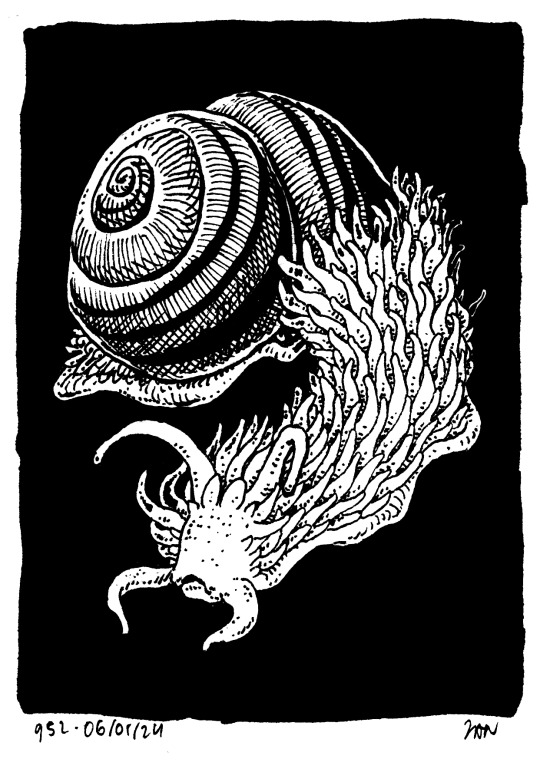
Carcolh, the 238th Known One.
#carcolh#lou carcolh#France#Gascogne#idk why i thought it was some kind of dragon but... not at all#just a hairy slug#i interpreted the hairy like this but i wonder if it wouldnt but good with just fur ahah#nudibranch#snail#Europe#monster#chimera#bestiary#creature design#ink#the Known Ones#952#octem 119#aqva 4
204 notes
·
View notes
Note
I love the shape language for Machete and Vasco, how angular and pointy the former is VS how round and soft the other... It's so GOOD I adore that
Thank you! I like the contrast as well, it makes them very fun to draw together. I try to keep them visually distinct while still making sure that they look harmonious and complementary next to each other.
#some more design musings that I've noticed that don't really matter but I tend to think about when drawing them:#Machete's shapes have an upward direction the ears the neck fluff and even the tip of his snout has that upturned angle#while Vasco's vibe is more loose and relaxed his huge floppy ears almost make him look like he's melting#neither of them have strong markings but the positioning of the gradients they have is very similar it's just different colors#Vasco has dark almond eyes (with what I can only describe as disney eyelashes)#his irises appear nearly black but if you shone a strong light directly on them they'd reveal a honey/amber hue#Machete's eyes are big and prominent with disproportionally small pupils#lately I've been drawing him with just the faintest salmon colored irises#but if the color scheme of the piece calls for it they can be depicted more vividly red#Machete has longer untameable fur here and there while Vasco is uniformly smooth and velvety#Machete is supposed to be the serious and inhibited half of the two but his face has a lot more expressive potential than Vasco's#it's actually kind of a struggle that I can't make Vasco emote with his ears at all those are typically a huge advantage in furry art#Vasco's body language is open and casual he takes up space confidently#Machete is usually very closed and defensive he has a habit of crossing his arms and legs and keeping his hands together and close to body#in general Vasco shouldn't be wearing anything black or red and Machete can't be seen wearing blue or gold#white is neutral territory it's usually the color of sleepwear and undershirts and as a result has a more intimate tone to it#answered#ardate
230 notes
·
View notes
Text


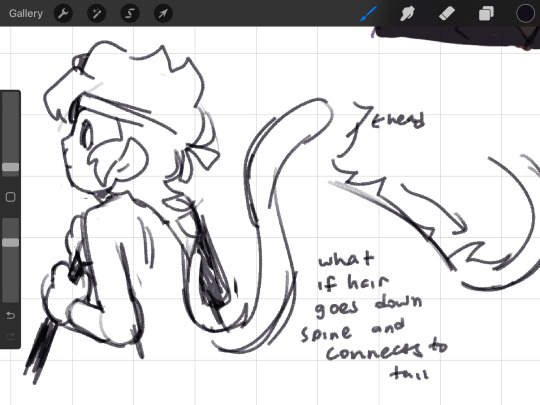
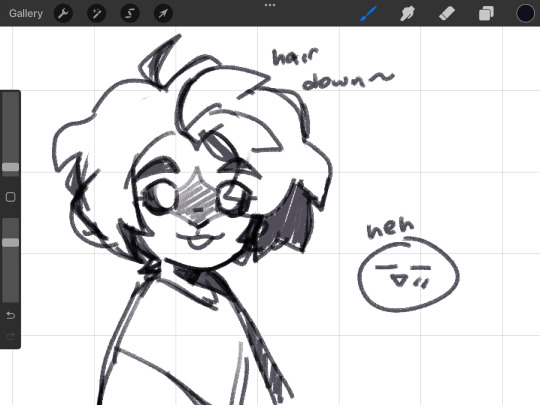

mmm, mmonkey
#figuring out how to draw them#it’s that sun/moon symbolism baby. they literally put it out for me it’s like catching fish in a barrel stg#I wanted macaques hair to be slicked back because it kind of reminds me of the curve on a crescent moon#like the dip at the end kind of reminds me of the tip of the crescent somehow idk#I’m trying not to draw stuff related to spoilers but it’s soooo harddddd. I can’t wait for the English release I need that serotonin NYEOW#MACAQUES ART THOUGH.. LMAO#without context it looks like he just made DLC for wukongs game and force fed it to MK#also decided instead of having fur covering the shoulders and chest maybe make it a glorified mullet#so the hair goes all the way down from the hair to tail on the spine#SO MANY DRAWING IDEAS IN HERE#myart#my art#doodles#Lego monkie kid#monkie kid#lmk#macaque#six eared macaque#lmk macaque#lmk six eared macaque#lmk sun wukong#lmk wukong#lmk monkey king#lmk MK#lmk xiaotian#monkie kid MK#lmk fanart#monkie kid fanart#fanart#wanna draw Mei next. I have a cool ass idea
974 notes
·
View notes
Text
If I ever had a bug character/sona I think I'd want it to be a Red Milkwood beetle because of a cute photo I took of one years and years ago, I've posted it a lot but it's my favorite piece of photography I've done
#zia goes on#my fav sona types are arthropod avian and scalie#all da best#but any kind of character that has like#multiple textures like feathers with fur and/or scales and any combo like that#is also very high tier
166 notes
·
View notes
Text
Some scholarly notes about the Grimm fairytales (1)
Recently in France (well... for the last two dozen years), the publishing house José Corti has been specializing itself in scientific fairytales collections. While for the study of literary fairytales one would go towards Honoré Champion, when it comes to folktales and fairytales it is José Corti one must check. In their "Merveilleux" collection they have been publishing for the very first time in France or republishing out-of-prints collections of various European fairytales (from Denmark, Spain, Romania, and more) - with a few classics of the "literary" fairytales that marked deeply the evolution of the genre (such as Straparola's Facetious Nights or Ludwig Bechstein's fairytales).
All of that to say, José Corti has in 2009 published the most recent scientific (but for an all-public) edition of the brothers Grimm fairytales. The full collection of their fairytales, translated accurately in French, with annotations about their type/classification, their evolution throughout editions and their predecessors. I can't share all of these annotations with you, of course, but I can share a handful of them, about the most famous stories of the Grimm. They all come from the same person who translated the story in this edition: Natacha Rimasson-Fertin. (Of course my notes might be incomplete but hey, you'll have to buy the books to see the whole thing :p Or check them out at your local library)

The devil with three golden hairs (Der Teufel mit den dre goldenen Haaren)
This story is at the crossroa between the Aa-Th 461 "Three hair from the devil's beard" ; the AT 460B "The quest for fortune" and the AT 93à "Urie's letter/The prophecy".
In the 1812 edition, there were two different versions of this tale. Story number 29 "The story of the devil with three golden hair", told by Amalia Hassenpflug, and number 75, "The phenix", told by her sister Mary. In the second version the devil was replaced by a phoenix, and the hero had to get three feathers. In the 1819 edition the two stories disappeared and were replaced by the version we know today, told by Dorothea Viehmann. Another version that the Grimms had collected in 1812 had a princess falling in love with the woodsman that cuts a tree below her window.
The final episode, where the hero asks three questions to the devil through the old woman, echoes the Pentamerone's "The Seven Doves". Other versions of this story include Asbjörnsen-Moe's "The wealthy Peter Krämer", and Afanassiev's "Marco the Wealthy and Vassili the Unfortunate". The story of the brothers Grimm gathers several references to the Bible: the child throw in the water echoes Moses' abandonment, the letter meant to kill the hero is similar to the one David uses to kill Urie, finally the hair as holders of a being's wisdom and strength is linked to the legend of Samson and Dalila. But many other elements of the story evoke older faiths. The idea of a body of water as the frontier with the Otherworld can be found in the Classical Antiquity with the Greek Charon, and is found in other stories of the volume, such as "Frau Holle" and "The Iron Stove" - it as believed that water formed an obstacle spirits could not cross. The hero's mission recalls a tale of Saxo Grammaticus where Thorkill enters Utgard (the realm of supernatural beings) to steal a hair from the beard of Utgard-loki. The brothers Grimm had noted that the belief in the exceptional fate of a child born with a "hood" was also found in Iceland, where the "caul", called Glückshaut (skin of luck) was the home of a genie that would follow the child all of his life. And indeed, modern research has proven that the name given to this caul, the "fyljia" was also the name of a spiritual double, a tutlar spirit tied to a person or a family. This is why the tradition was to preserve and hide this "pileus naturalis" - in Belgium, it was called a "hem" and its color allowed for divination rituals about the child's future.
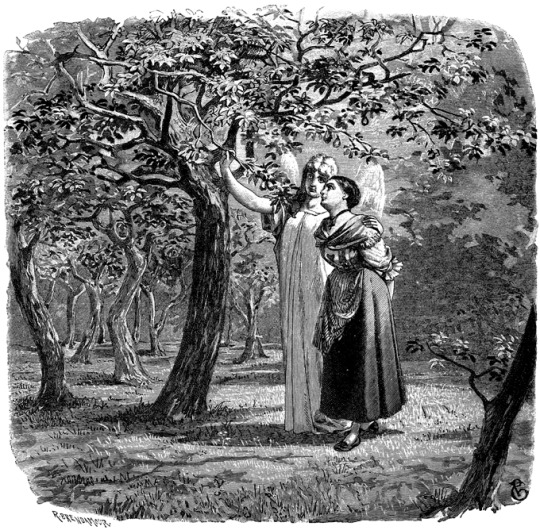
The girl without hands (Das Mädchen ohne Hände)
This fairytale is actually a cross between the AT type 706 "The maiden without hands" and the AT 930 "Urie's letter/The prophecy". The story was created by the brothers mixing two versions from Hesse, one told by Mary Hassenpflug, the other by Dorothea Viehmann. The second version lacks this story's introduction and begins with a father trying to marry his own daughter - when she refuses, he cuts off her hands and breasts, and chases her out of his house. It then follows the story. Meanwhile, the first version differs when the heroine is with her child in the forest: an old man tells her to hug three time a tree with her arms, which makes her hands grow again. He also tells her to only open the door of her house to one who will ask to enter "for the love of God" three times in a row - the king will be forced to do this before entering.
Outside of these two main versions, the brothers Grimm collected three additional ones. In the first, the angel that guides the girl is replaced by a small light that descends from the sky ; and the hands of the girl grow back when she plunges her arms in a stream after seeing a blind mouse enter its water to regain its sight. In the second version, a man is upset at his little girl praying for him day and night, but since she refuses to stop despite his demands, he cuts off her tongue. But she prays in thought and makes the sign of the cross, so he cuts off her right hand, then her arm all the way to the elbow, before banishing her. She is saved by a hunter that hides her in his master's domain and feeds her in secret with his master's dogs. When the master discovers this, he decides to raise the girl as his own child. One day she gives money to a poor man, who tells her she will regain her arm and tongue if she goes to drink of a certain stream, and he gives her a magical staff to protect her. When she returns at the lord's house, he marries her. The third version is about a queen banished by her husband with her two children, and is identical to the legend of saint Helen.
Other international versions of the tale include Zingerle's "The pretty daughter of the innkeeper", Basile's "Penta the one-armed girl" and Afanassiev's "The young girl without hands". There are some versions where it is a man that is mutlated, such as Afanassiev's "The brave without legs and the blind brave". The roots of this story date back to the end of the 12th century, and are located in southern England - this tale was the subject of numerous literary adaptations, the most famous being the verse romance of the 13th century "The Beautiful Helen of Constantinople".
The motif of the child sold to the devil is recurring among the Grimm fairytales - even though the character of the devil can be replaced by another supernatural being, such as in "Rapunzel" or "The Nixie of the Mill-Pond". The idea of offering the first thing one sees upon returning home is as old as the Ancient Testament (Judges). This story bears the signs of a heavy Christianiation, and was clearly inspired by the legend of Saint Genevieve of Brabant, falsefely accused of being unfaithful and condemned to death with her newborn child. The executioners take pity on her and she lives alone in the woods for seven years. As with other tales from the Grimm collection, this story mixes the Christian fantasy (the hands that regrow are treated as a Christian miracle) with pagan fantasy (there are several elements of folk-magic, such as the circle the girl draws around her to be protected from the devil, or the accusations of the queen giving birth to a changeling - a changeling also appears in the third story of "The Elves", KHM 39).

The Robber Bridegroom (Der Räuberbräutigam)
This story belongs to the fairytale type Aa-Th 955, named after it: "The robber bridegroom".
The tale was told to Jacob Grimm by Mary Hassenpflug, and was present as early as the 1810 manuscript. However this first version, that the brothers deemed "incomplete" was replaced from the 1812 edition onward by a new version which mixed two versions from Lower-Hesse. The brothers noted the existence of another version where the robber indicated the road to his house to a princess, by tying ribbons around the trees.
Ludwig Bechstein took inspiration from the brothers Grimm's tale to create his own "The Robber Bridegroom". This fairytale, like "Fichter's Bird", belongs to the "Bluebeard cycle" (several tales that the brothers removed from their first edition also belonged to this cycle).
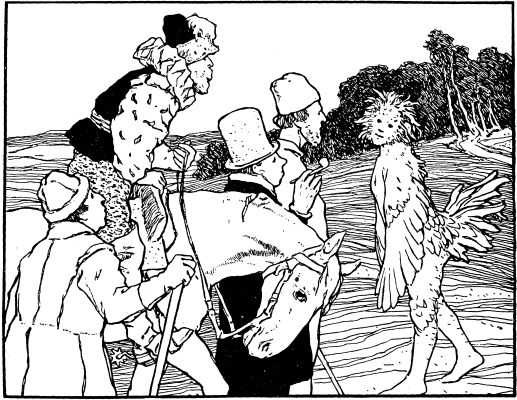
Fitcher's Bird (Fitchers Vogel)
This tale is a variation of the Aa-Th 311 "The heroine rescues herself and her sisters", usually classified under the "Bluebeard" category.
The final text of the Grimms is actually a mix of two different versions of the same story that was told to the brothers by both Friedrike Mannel and Dortchen Wild. The Grimms noted the existence of a version from Hanovre which goes as follow: a poor woodcutter asks his daughter to bring him his meal in the forest, and to show them the way he places peas on the floor. However dwarves notice this, and change the emplacement of the pea so that their path leads to their grotto. The older girl follows the peas, and become the dwarves' slave. Then we have the Bluebeard "forbidden room" motif, and the story goes as the "Fitcher's Bird" goes, as the dwarves lure the two other sisters to their cave. The last sister sticks the feathers on her body by rolling herself in blood (presumably the blood of the dwarves' victims), and there is no resurrection of the sisters. Everybody that meets her on the way call her "geputzter Vogel". The dwarves hunt the girl down and almost catch her just as she reaches her father's house - she is so fast in closing the door that it cuts a piece of her heel. The Grimms also knew of a Dutch version of the story, translated in German, and that was identical to one of their first-editions tales, "The Murder-Castle".
The translation of the name of the "bird" always caused many problems, due to the difficulty of understanding the expression. The brothers Grimm themselves explained the name of the bird by the Icelandic "Fitfuglar", meaning "birds that swim" - as such, the girl would be called "Fitchers-Vogel" because she looks like a swan". However, other people do not agree with this etymology, some linking Fitcher with "Fitze", the thread. Rimasson-Fertin highlights that the expression "Fitchers Fitze", outside of a simple sonority game, might be two variations of the male name Fritz (the diminutive of Friedrich) - other usual diminutives were Fitze, Fitz and Fiete. The brothers Grimm noted that the motif of the blood that cannot be erased was much older than Perrault's Bluebeard - it could be found as early as the "Gesta Romanorum", where a mother who had murdered her child couldn't erase three blood-drops from her hand, forcing her to wear a glove. This story must be compared to the KHM 40, "The Robber Bridegroom".

The Juniper Tree (Von dem Machandelboom)
It is the AaTh 720 "My mother killed me, my father ate me".
Just like the tale of "The Fisherman and his wife", this story was written by the painter P. O. Runge, and the brothers Grimm used it as a model for how they should present their own fairy tales. In fact, we can note sentences almost identical between the two tales.
The brothers noted a variation of the story where the stepmother places her daughter near the pot where her brother cooks, and she forbids her from looking inside. But since the pot boils too much, the girl lifts the lid - then her brother's hand reaches out to her from the cauldron. There is yet another version noted by the Grimm where there are three children, not two, and the stepmother sends them pick up strawberries in the wood, promising an apple to whoever comes back first.
The cruelty of this fairytale earned the brothers a serious criticism from Achim von Arnim - who only tolerated such violence because it echoed the one present in Goethe's Faust. The description "red as blood, white as snow" of course echoes the tale of "Snow-White". The brothers Grimm mentionned in their notes that the juniper tree was a plant believed to have the power to bring back youth - and Rölleke noted that the juniper-tree's red berries were used in folk-magic. It seems to be a very ancient tale due to several very old motifs such as the soul returning in the shape of a bird, a resurrection out of bones, and cannibalism. This tale must be compared to "Brother Lustig", "The Singing Bone" and, of course, "The Fisherman and his wife".

Briar Rose (Dornröschen)
Of course, it is the AaTh 410 "Sleeping Beauty".
This fairytale was present as early as the 1810 manuscript, written by Jacob Grimm from a tale told by Marie Hassenpflug. Research has proven that this story is derived from Charles Perrault's own Sleeping Beauty. We also find back in the German story a motif coming from another famous French literary fairytale, madame d'Aulnoy's "The Hind in the Woods/The Doe in the Woods" (also known as the White Doe). In this story a Crayfish/Lobster fairy announces to the queen she will have a child, and later the same fairy curses the princess as she is born - and what a coincidence! In the first edition of "Briar Rose", the animal that announces the princess' birth is not a frog... but a crayfish. Proving that there is a direct link. As for the name of the princess n German, "Dornröschen", "small briar rose", it actually first appeared in the German translation of a 1730 fairytale by Anthony Hamilton (an Irish man who however spoke and wrote French), "Fleur d'épine" (Thorn flower/Briar flower) - it had been translated in 1790. Bolte and Polivka have also noted a comedy by Gryphius from 1660 whch was named "Die geliebte Dornrose", "The beloved briar rose".
In their notes about the fairytale, the Grimm brothers explicitely compare Briar Rose to the legend of Brunhild asleep behind a wall of fire, cursed into a magical slumber by Odin's "sleep-thorn" and woken up by Sigurd, the only one able to cross the wall of flames. The brothers Grimm were also aware of Basile's version of the story, "Thalia, Sun and Moon", which they compared to their own Briar Rose in their notes. The brothers were very fascinated by the consistant naming of the princess' children from Perrault (Dawn, Day) to Basile (Sun, Moon) and compared it to the occurences of "Day, Sun and Moon" as names within the Eddas. However we know that Perrault was heavily inspired by Basile's story when writing his own Sleeping Beauty, and only modified some parts so as to erase the more shocking and "unpleasant" parts (such as the married prince having sex with the sleeping girl). Of course, this story is also to be compared with the 14th century medieval tale of the Roman de Perceforest.
The wise women that appear in this story are the Germanic equivalent of the fairies. In fact, we know that the brothers Grimm carefully avoided (or erased) any mention of "Fee" (the German word for the English "fairy" and French "fée") from their tales, so as to better differentiate them from the French "fairy tales", "contes de fées". By turning the fairies into wise women making predictions at the child's birth, the Grimms notably opened an entire set of symbolism and interpretations linking them to the mythological figures of the Norns, Parcae and Moirai.
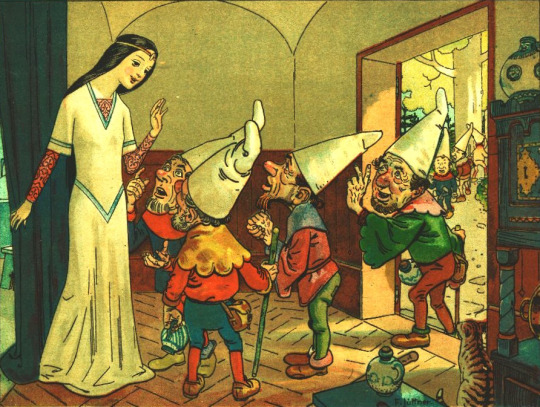
Snow White (Schneewittchen)
Of course, it is the AaTh 709 "Snow-White".
The full editing history of this tale was only "recently" recreated (the book was published in 2009, it was recent back then) in its entirety. We know that it begins in 1808 with a version collected by Ferdinand Grimm, brother of Jacob and Wilhelm, called "Schneeweibchen". It seems Ferdinand might have invented the story on his own. Wilhelm and Jacob then slowly modified it, by adding details from other collected versions, before publishing it in their first edition in 1810 (they did note at the time that it was a Lower-Germany story, and that in Upper-Germany the tale did exist but with the deformed name of "Schliwitchen". When the Grimms did their second edition, the main change they performed onto this story was the modification of the wicked mother into a wicked stepmother - something they also did for "Hansel and Gretel". In fact, from edition to edition the Grimms kept adding adjectives and expressons highlighting the opposition between the girl and the vain queen.
Th Grimms had collected several variations of the tale. One was much closer to the tale of "The Juniper Tree" and in it the queen, as she was with the king on a hunting sled, cut her finger while peeling an apple. In another variation the king and queen were walking by three mounts of snow, than went by three pools of blood, and finally saw three ravens in the sky, and each time the king wishes for a girl with the corresponding colors - soon afterward the couple encountered a little girl fitting this description. The king, immediately attached to her, takes her with him in their royal carriage, but the queen immediately hates her and tries to get rid of her - so she asks the girl to go seek a glove she threw out of the window, and while she is out of the carriage she asks the driver to leave as fast as he can. Then the little girl takes refuge at the seven dwarves' house.
The fairytale existed in German literature before the brothers Grimm published it. Indeed J. A. Musaüs had published in 1782 a fairytale called "Richilde" - and the Grimm were influenced by this tale, since in the margins of their first edition, they noted about Snow-White "It is Musaüs' Richilde". There was also a Snow-White story that had been published in 1809 in a fairytale book by A. L. Grimm (no relationship to the brothers Grimm). The Brothers Grimm did note the striking similarity between this story and the Norse pseudo-historical legend of Snäsridr, the beautiful wife of "Harald with fair hair", a wife that, when she died, stayed in her prime state so that it seemed she was still alive.
This fairy-tale has a very wide area of spreading, as it can be found from Ireland to Turkey passing by central Africa. It is especially present in the literary Italian compilations of fairytales. Basile has three variations of the story in his Pentamerone: "The raven", "Nennillo and Nennella" as well as "The she-cook".
The various virtues that Snow-White shows in this tale made her one of the big role models within the education of bourgeoisie girls in the 19th century - alongside Cinderella, of course. In fact, according to H-J Uther's analysis of the story, it is because of all her virtues that Snow-White's beauty does not fade away and stays undamaged even in death, unlike her wicked stepmother whose vices causes the fading of her charms. Finally, this fairytale is actually the proof that the brothers Grimm did not simply listed their fairytales one after the other in a random order, but deliberately created "bridges" and internal references to create a cohesive world within their book. Indeed, the mention of the snowflakes looking like feathers references "Frau Holle", while the glass coffin can be found back in, of course, "The Glass Coffin", and the blood-drops on the snow evokes "The Juniper Tree".
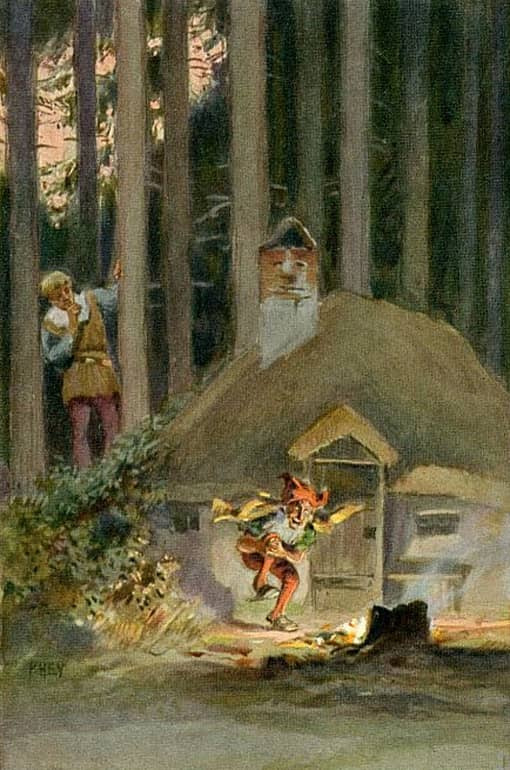
Rumpelstilzchen
Yes this story is the famous "Rumpelstilskin" (or Rumpelstiltskin? I never know how to write it in English). But why keep the German spelling? Because Rimasson-Fertin has some stuff to say about it: this name is the diminutive form of "Rumpelstilz", a term that Jacob Grimm defined in his "German Dictionary" as being synonymous with "poltergeist" (he noted a similarity between Poltergeist and Rumpelgeist, both designated a very loud spirit). While today "poltergeist" is mostly associated with ghosts, in a much broader way it designate a dwarf, a dead or a devil - or just any kind of phenomenon caused by witchcraft.
This story corresponds to the AaTh 500 "The name of the supernatural being". This fairytale has an interesting evolution history... Jacob Grimm had a version of it as early as 1808, named "Rumpenstünzchen", which was then slightly modified for the 1810 manuscript. This tale was actually the mix of two different versions - and one of these versions had a different ending. The queen didn't sent messengers searching for the dwarf's name, rather the king spotted the little man while returning from hunting on the third day. The Grimm also noted a variation where the initial situation was reversed: a young girl who had to spin hemp but could only manage to spin gold much to everybody's despair, and a small man appeared to promise her a wedding to a king's son in exchange for her firstborn child. It ended in such a way: the queen herself spotted the small man singing his name, jumping around a fire while riding a ladle like a horse. When she guessed his name, he flew out of the window and into the sky, riding the ladle like a witch's broom. We know that the episode of the spinning of the straw was only added by the Grimm in 1812 (it is not in the 1810 version), and that the final scene of the dwarf self-mutilating comes from a story of Lisette Wild and was added in 1819.
The first literary record of this story is a French fairytale published in 1705 and written by Mlle Marie-Jeanne L'Héritier de Villandon. It was "L'Histoire de Ricdin-Ricdon" (The Tale of Ricdin-Ricdon), published in her "La Tour ténébreuse et les jours lumineux" (The Shadowy tower and the luminous days). It had been translated in German by Johann Gottwert Müller in 1790, under the title "Straubfedern", "Ostrich feathers". As for the name "Rumpelstilzchen", it actually originates from Johann Fischart's Grman adaptation of the French "Gargantua", "Geschichtklitterung" (1584) - in it, Fischart lists various children game by name, and mentions a "Rumpele stilt oder der Poppart".
This fairytale type is very present in Western, Central and Northern Europe (British Isles and Ireland included), with also a few spottings in the Baltic countries, China and Japan. The name of the supernatural being always changes from one region or country to the next (in Swiss it is Hans-Öfeli, in Dutch Trillevip, in Swedish Titteliture, in Finnish Tuttirituli, in the Suffolk it is Tom Tit Tot, in Welsh Gnarwynathrot, in Irish it is Eve-Trot or Trit-a-Trot...). It is part of the enormous success of this tale-type: every country has to invent its own brand of nonsensical, un-guessable name. As for the rhymed song through which the dwarf betrays its name, it is found in England as "Nimmy nimmy not / My name is Tom Tit Tot", and in an Afro-American version of North Carolina "I'm so glad that she do not know / That my name is Tabutoe Tambutoe".
The brothers Grimm noted that in Germanic mythology it was typical for underground beings (aka dwarfs) to have names that are not usual among humankind, which is why, again according to them, the dwarf of this story would feel in perfect safety proposing the queen such a game. The rule according to which obtaining the name of a supernatural being means gaining a form of power over them is very common, and is even reused in another one of the Grimm stories: KHM 136, "Iron John". H. Rölleke did an analysis of the names the queen proposes at first: we have the three names of the Magi, aka the Three Wise Men, or King-Magi, which gives a Christian setting to the story, and could also serve as a metonymy for all the saint names found in the Christian calendar. As for "Heinz" and "Kunz", Rölleke sees in them the diminutives of the names of the medieval emperors Heinrich and Konrad, which used to be some of the most popular male names among German-speaking countries.

All-Kinds-of-Fur (Allerleirauh)
It corresponds to the AaTh 510B "The dresses of gold, silver and stars", also known as "Donkey Skin", after the famous Charles Perrault fairytales.
The story we read today was the one told to the Grimm by Dortchen Wild, but there was a variation of it told to the brothers by Jeannette Hassenpflug, "Princess Mouse-Skin", which was present in the 1812's edition of the volume (n°71) but was then moves to the annotations as a mere mention. The version of the story from the first draft (the 1810 manuscript) was called "Allerlei Rauch", "All Kinds of Smoke", and was heavily inspired by one of the tales present within the novel "Schilly" by Carl Nehrlich.
The line "God forbade a father from marrying his daughter. Nothing good can come from this sin which will cause the kingdom's decadence" was added in the 1819 edition, and references a tale of Albert Ludwig Grimm called "Brunnenhold und Brunnenstark". The brothers Grimm insisted even more on the condamnation of the sin of incest when rewriting the story for their "small collection" for kids, and also insisted heavily upon a political extension of such a decision, which would damage the state itself. It is actually an allussion to the failure of the Frankfort Parliament, which had been gathered in 1848 at the Paulskirche in an attempt to create a constitution for all of Germany - to which Jacob Grimm had taken part.
A variation of the story collected in Paderborn has the last coat made of all the furs of the kingdom, plus moss and various forest-related material. In this version, the heroine puts the cloak on top of her three beautiful dresses before fleeing, and she hides in an empty tree where she is discovered, not during a hunting party, but by woodsman that cut off the tree she was sleeping into, to bring wood to the king. All-Kinds-of-Fur works in the castle's kitchen but one day as she is preparing the soup, the king has her sit on his chair so she can delouse him (a motif also present in "The Devil with Three Golden Hair). As she does, the king glimpses the beautiful shining dress under the cloak's sleeve, and this is how he discovers the girl's true appearance. Another variation of the story yet, also collected in Paderborn, has the heroine pretending to be mute. One day the king hits her with a whip, it rips apart the coat, revealing the golden dress underneath.
Not all the German versions of the story include the incest motif. In Musaüs' take on the story, "Die Nymphe des Brunnens", "The Nymph of the Well", the heroine leaves her father's castle because it has been destroyed. Her godmother, an undine, gifts her a small magical box and when she leaves the ball she says "Night behind me and day before me / Might nobody see me!". As for the version of Hassenpflug, "Princess Mouse-Skin", it begins as the KHM 179, "The Goose-Girl at the Well": a king wants to know which of his three daughters love him the most, the first says she loves him more than the whole kingdom, the second more than pearls and precious stones, the third more than salt. The furious father has the last princess be sent into the woods to be killed, but the servant tasked with the execution spares her out of pity, and gives her, by her request, a coat made of mice skin. The rest of the story goes like within "All-Kinds-of-Fur", except for the final wedding, to which the father-king is invited. All the dishes served to him are without salt, and he ends up saying he prefers to die rather than continue eating without salt. The princess-daughter reveals herself and points out how he tried to had her killed for loving him more than salt. Her father begs her for forgiveness, and the tale ends with her accepting.
The motif of the incest can, however, be found back in a variation of the KHM 31 (The Girl Without Hands) that the Grimms collected, and where the father mutilates the daughter for refusing to marry him. The motif of the king trying to marry his own daughter has been attested in many, many European stories ever since the 12th century. As for the boots that are thrown in the heroine's face in the Grimm story, while in the final edition it has no follow-up, in the 1812 edition it was a recurring element forming a motif within the tale. Another German version of the story that preserved this structure that the Grimms erased is the story collected by Vernaleken, "Throw-Broom, Throw-Brush and Throw-Comb". In it the king throws out of anger at the face of the heroine (Adelaide) a broom, a brush and a comb. Every time she goes to the ball, she changes her pseudonym to fit which item hit her (one night she is "Throw-Broom", another she is "Throw-Brush", etc...). There are many, many variations of the story containing such a "name play".
Other famous examples of this variation, outside of Charles Perrault's Donkeyskin, include Straparola's "The maiden in the chest", Basile's "The She-Bear", Afanassiev's "Pig-Skin".
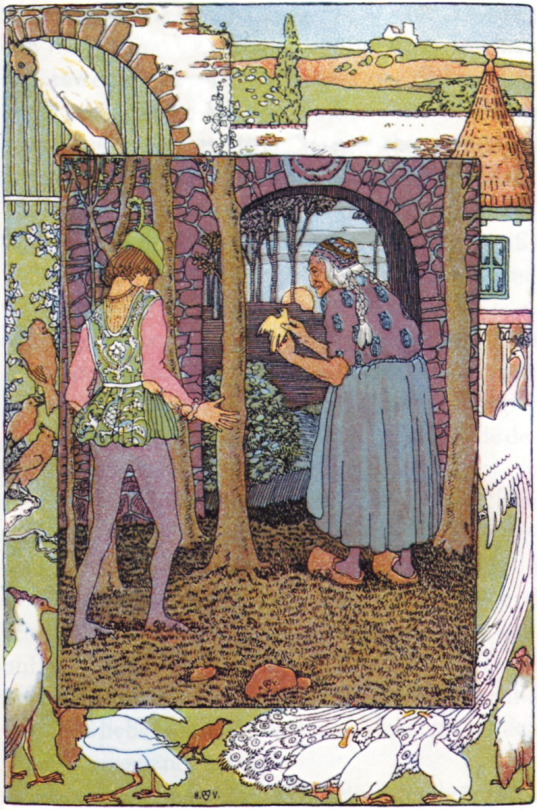
Jorinde and Joringel (Jorinde und Joringel)
It corresponds to the AaTH 405, named and created after this story, "Jorinde and Joringel".
The interesting thing with this story is that the brothers Grimm did not collect it from a direct source. Rather they lifted it, to the exact word, from the autobiography of Johann Heinrich Jung, "Jugend/Youth", published in 1779. The brothers deemed that the way Jung-Stilling had written the tale was the "perfect" way to tell the story, according to their definition of a fairytale. Though they did note the existence of a version of the story told in Schwalm - but which differs very little from the story of Jung-Stilling.
The brothers Grimm themselves noted a similarity between this story, and the KHM 123, "The Old Woman in the Wood". Rimasson-Fertin notes that the witch in this story is to be compared to the ones appearing in "Hansel and Gretel" and in "Little Brother and Little Sister". As for the name of the demon the witch invokes, "Zachiel", H. Rölleke identified it as a form of "Zachariel", a demon name coming from the very popular 17th century demonology grimoire "Clavicula Salomonis", "The Clavicles of Salomon".
#brothers grimm#grimm fairytales#brothers grimm fairytales#german fairytales#sleeping beauty#briar rose#snow-white#snow white#jorinde and joringel#all kinds of fur#the juniper tree#the devil with three golden hair#the three golden hair of the devil#the robber bridegroom#the maiden without hands#the girl without hands
24 notes
·
View notes
Text
little rich boy sirius who gets disowned and can barely survive without his expensive brands and the basic human need to eat at least once a day meeting the entirely too generous james potter who just falls for the vanity and sincerity of the reformed rich boy and decides that once sirius stops caring about brands and status and rich boy things and just cares about what matters in life he decides to spoil his boyfriend to pieces because he’s secretly sitting on a fucking fortune
#idk i just think it’s funny#like james would find sirius when he’s struggling with money because he’s so bad at saving and prioritising his spendings because he’s never#had too before and so james would teach him how to do all that stuff and emotionally support sirius through it all and sirius just falls in#love with this beautiful guy who’s just so generous and who teaches him so many things and finds value in kindness and sincerity and#compassion and all that jazz and james falls in love with sirius helplessly because he might be stuck up and vein and kind of selfish and#is stuck up and cares all too much about status but he’s trying so hard to be better and he finds empathy because sirius got kicked out for#the worst reasons because he’s always been the black sheep of his highly cultist christian family or whatver and he’s also outwardly queer#and james decides that he wants to give sirius everything and loves the way he looks in expensive makeup and designer faux fur coats and#heels and divine jewellery and all that jazz but makes sirius sell it all and learn what it means to be human and not rely on money and#status and brands and stuff and sirius learns what it’s like to be decent and in touch with humanity and only then does james take sirius on#a surprise luxury holiday for his birthday or something and then just buys him thousands of dollars worth of all these glamorous looking#things and sirius is like omg what the fuck jamie and then he just becomes sirius’ sugar daddy because he can’t help himself but they’re#also in love and much better people because of it and when sirius buys things now it’s not because of brands or because they have big price#tags like he used too. he now buys things with james’ credit card he keeps in his own wallet because he thinks he’ll feel pretty in them or#because he thinks james will loose it if he sees sirius walking around in it or if he sees a really cute toaster that sends him into a#frenzy that has him spending all way too much on an impromptu kitchen renovation but james doesn’t care because as long as his boyfriend is#happy and actually paying attention to the price of things and calculating the best value and taking james’ opinion as well and just being#happy and safe and accepted in his new home and family here with his jamie#please i think they’d be so cute ugh!!!#prongsfoot#bambibelle#drabble#fic idea#marauders#james potter#sirius black#jay talks
56 notes
·
View notes
Text
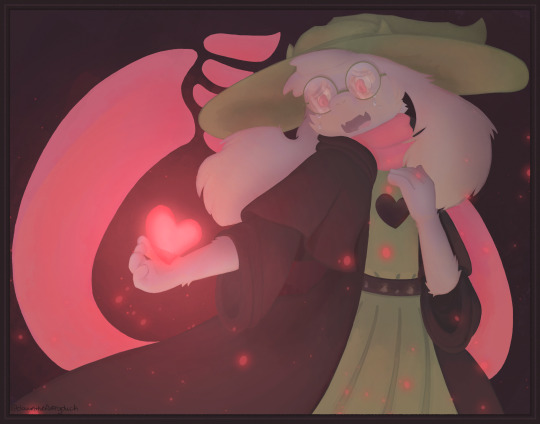
hey that's not supposed to be out there (uploaded wrong version at first haha whoops)
#not supposed to be that color either#i wonder who that belongs to#i had a very vague meaning for this in mind but saying it would spoil the fun#christ this took me forever#i wanted to do a quick project to give myself a break from my final#but accidentally made an entirely new kind of nightmare#BUT i can proudly say that i am very proud of this despite how long it took me#alrighty this blog is all about tracking progress so my thought on this;#it's not really as energetic as i had hoped to make it so i think that's the biggest technical issue i have with this#i'll try to get back to doing more gestures soon as a way to help with that#i think my shadows are a bit confusing too#i'm looking at it now and his glasses kinda taper off into the void of his fur bc i didnt mark the shadow along the left of his ear#but the thought of digging back through layers to fix it and blending that mess in is giving me a headache so i'm content with leaving it#i think i learned a lot about light and reflections though#my shadows aren't the greatest but i had so much fun rendering the glasses#and the glow of the soul pushed me to think about bounce light a lot more#figuring out how to make the colors look like they were glowing was a whole separate issue#i did it in the last big ralsei drawing i did but not nearly to this extent#i won't be doing something this large for a while after this but i'll keep trying to work on the things i didn't like about this#i think i'm gonna start putting my self-crit in the tags from now on#it really does bulk up the posts and it's hard to scroll past#i like reflecting on my work like this though#i've been able to draw a lot more since i've started doing it because it helps me create specific goals for myself#lets me keep pushing myself while still having fun with my art#ralsei#deltarune#deltarune fanart
47 notes
·
View notes
Text
Another remark about Donkeyskin...
While the different versions of the tale vary in how much blame is put on the king for trying to marry his daughter, one thing seems consistent: the king is always willing. No matter how much the retelling contrives to use outside forces to manipulate him into it, and whether his willingness is attributed to "madness" or not, he always has genuine incestuous desire for his daughter.
None of the versions printed in Cinderella Tales From Around the World make him reluctant about the match in any way.
I only know one version of this tale where the king is reluctant, but feels he has no choice, and it's a modern adaptation: Sapsorrow from Jim Henson's The Storyteller. In that version, the fateful ring that fits the princess isn't just her mother's ring, but a ring that every queen of the land has worn for centuries, and by law, the reigning king must marry the first maiden he finds whose finger fits it. When the ring fits his daughter, the king is just as horrified as she is, but he feels bound by the law to marry her.
I guess that while part of the aim of Jim Henson's The Storyteller was to produce darker, more mature fairy tale adaptations than modern audiences are used to, it was still a family series. They couldn't take the child-unfriendly themes too far.
10 notes
·
View notes
Note
Do you think Home and Bardaby would end up- if not friends than at least allies eventually in your fantasy au? I think it would be a real shame if Wally's best friend & his patron couldn't find some common ground. Maybe they could both keep an eye on Wally for each other? I know Home is literally Always There with him, but there are some human(puppet?) issues that an elder god just wouldn't really get. idk, I just think it's a bit of a shame that they don't get along, since Barnaby's the only other person besides Wally to actually interact with home in the original ARG.
oh no yeah! they do Eventually! it just takes a while and some work. Home in this au is pretty protective of Wally for Reasons, and it takes a lot to make them go "hey, you're chill. i like you". unfortunately Barn is also protective (not nearly to Home's extent but yk) so they naturally clash where they should get along
i have the full process In My Mind but essentially: Home, if given express permission, can "possess" Wally (put in quotes bc technically Wally is already possessed by them). this happens either when Wally wants a fucking break / is overwhelmed and wants Home to take the wheel (Wally's consciousness is kinda 'turned off' - it falls into a deep sleep!), or if Home does Wally a favor - they trade the favor for a set amount of possession time. because Home would like to have a body & make the decisions from time to time <3
during one of these "Home has the wheel" periods, i imagine that some shit goes down that forces Barnaby & Home to work together w/o a mediator. and during this time they're trying to get through this while keeping Wally's body relatively unharmed - Barnaby experiences a nice disconnect of "this is Wally but its also not Wally & its also a being i don't like very much bc its a dick-". but through the power for Forced Interaction, they realize that yeah, they have common ground, but they're also not too bad :]. catch Wally taking the wheel and being perplexed at how Barnaby is all "hey say hi to Home for me!" or asking for Home's opinion on things.
#ofc everyone else is startled by the change bc they weren't around with barn & home#while they were on their buddy bonding adventure <3#its tough for home to connect both bc Yea they're an ancient being very out of touch with everything#but also home Cannot Speak! in any form! in house form they speak in onomatopoeia as in canon!#in full unrestrained form they make scary monster noises & house noises! in wally form they cant make noise at all!#bc when possessed wally's face gets entirely blacked out (except for the eyes) and essentially turns into a mini void </3#and no one understands the ancient lost language of ~morse code~#so there's a huge communication barrier! plentiful misunderstandings & misinterpretations!#also a plus of banraby getting attached - now there's Two people to worry about all packaged up in One!#oh and i imagine barn is allowed to join wally for his 'painting for house home' sessions going forward#rambles from the bog#wh fantasy au#also! technically none of them are puppets in this au except for Kind Of wally#their fleece/felt is fur/fluff/fuzz!#their stuffing is replaced with blood & guts & bone!#cut them & they bleed yk yk!#they got them Fluids!#that sounded better in my head. i lied no it didnt#& sure yeah why the fuck not they have retractable teeth#in my mind there's different classes - like howdy is an insectoid - eddie/frank/wally/sally/julie are all humanoids#barnaby is an... uh... animoids?? does that work??#poppy is an avian <3#& then monsters are yk. Monsters. animals are animals. etc#anyway i imagine that wally is Very pleased when his bestie & his patron start clicking#he gets so happy whenever barn asks after home <3
41 notes
·
View notes
Note
hello beans!! hope you're doing well 💜 ^w^ I know you've probably gotten a lot of requests - but I'm gonna add to that pile anyway because it's fun and also your writing is wonderful and always cheers me up to read!! I'm so inspired by your drabbles and you really bring these characters and this little world to life ;w;
From drabble list #1:
14. "Please tell me, this is not why you woke me up."
Character(s): honestly anyone, but my gut was saying Es as soon as I saw that sentence so... up to you!
Woo thank you pal, same to you!! Thanks for your kind words ah ;--; This is the perfect line for Es omg, I've been cracking up over it for so long 😂 I was tempted to write them waking up for T2, taking one look around and going "uh-uh," but decided on some T1 comedy...
Es rarely dreamed. Usually it was vague images and thoughts. Sometimes it was just them thinking about breakfast the following morning. Occasionally they were plagued by a nightmare of being forced to sing karaoke with the prisoners. Most of the time, though, it was just silence that welcomed them at the end of the day. Wonderful, peaceful, silence.
BANG-BANG-BANG!
Someone slammed their fist on the door. Es just about fell out of bed.
Mikoto’s voice came from outside. “Oi, get up! There’s been… uh… an incident!”
That was the last thing a prison guard wanted to hear at -- Es checked the clock -- 2am. Damn.
They muttered to themself as they threw on their uniform. Why the prison’s cells didn’t lock was beyond them. Some of the prisoners were more troublesome than others, but the first trial had been going smoothly thus far. Why now?
Their mind flashed with various possibilities, each one worse than the last, all urging them forward. By the time they were running down the hallway, their shirt buttons were a row off, and they had to switch their shoes to the opposite foot. They adjusted the cap clumsily on their head.
Fear gripped their chest as they heard Jackalope’s voice crying out for help from the panopticon. Jackalope never called for help.
Es burst into the room. The prisoners froze, looking up guiltily.
They sat in a huddle on the floor. Yuno and Muu held the little furry warden over a tub of sudsy water. Bottles of soap and shampoo sat nearby. An assortment of brushes and combs sat to the side. Splashes of water spread across the prisoners and ground, speaking to several failed attempts at getting Jackalope into the bath.
Nearby, Mahiru was holding up the tiny guard’s uniform, her sewing kit spread out on her lap. Es spotted bandages on Yuno’s and Kazui’s fingers. Shidou was currently dabbing blood off Fuuta’s nose as he fumed. Jackalope leaned over to nip at the hands holding him, but Yuno and Muu held him fast.
“Es!” came his frantic voice as he thrashed around. “You gotta help me! Make them stop, dammit!”
From the group of prisoners who had been watching from a distance, Haruka turned to them. “Oh! Es! Th-they thought that he needed a -- uh, a bath! His uniform had a h-hole, and Mahiru can s-sew! And they thought, they thought we could do it all t-together… Muu called it a -- a spa night…”
“At two in the morning?” Was all that came to mind.
“We tried to get him to do it earlier today,” Muu said, “but we didn’t get a chance until now.”
“They didn’t get a chance to kidnap me, she means!” He squirmed around some more, swinging his antlers wildly. “They hid around the corner and nabbed me like the filthy criminals they are!!”
Yuno said, “hold still,” as she brought him closer to the water. He kicked his feet wildly, screaming at Es to show a little authority and do something.
“Hold on a second,” they stopped her.
They closed their eyes, pinching the bridge of their nose. They took a measured breath. They were here to contemplate sin and crime, guilt and forgiveness. Their job should have consisted of questions about morality and life and death; they never anticipated looking around their prison and asking, “is human shampoo even safe for his fur?”
Kotoko spoke up from the other side of the room. “That’s what I thought, but is he really a rabbit? He eats human food and everything, we didn’t think a bit of soap was that different.”
Jackalope disagreed (“that stuff is as bad as poison -- poison I tell you!”) but the others chimed in with their agreement. From around the room came promises that they were being gentle with him, and that they’d keep quiet, and that they’d dry and brush his fur really well when they’d finished, and that they’d feed him treats, and that his uniform was already good as new, and so on. A few complaints at getting bit mingled with Jackalope’s own insults.
“-- Alright.” Es held up a hand to silence them all. They knew a warden shouldn’t be making compromises with their prisoners. At the same time, they didn’t have the energy to argue about bunny baths at this time of night. “You can continue, but wash him outside of the tub. And go easy on the shampoo. Any mess you make must be cleaned by morning.”
They were met with excitement and thanks. Jackalope grumbled that they were too soft, but he sounded relieved as he was whisked away from the dreaded bathwater.
Es sighed. There may have been a few bites and bumps, but that was all. No emergency, no fight, no danger plagued Milgram tonight. Their relief quickly turned to annoyance. They leveled their gaze at Mikoto as he entered from the hallway behind.
“Please tell me this isn’t why you woke me up.”
“Huh? Oh, this? No, no -- we have everything under control. Aw, Mappi, that looks great!”
He pointed at her sewing job, revealing bandages on his hands as well. It looked like no one was safe from the rabbit’s little teeth… Then Mikoto jabbed a thumb casually over his shoulder. “Nah, the faucet in the men’s room broke when we tried filling the basin. The whole room’s flooded now. I think it’s gonna start spilling into the hallway soon.”
“WHAT?”
#milgram#es#jackalope#mikoto kayano#and some others#rip es... they are eternally dealing with So Much Bullshit.... 😂😂😂#half the fun was actually writing it and the half of it was sitting around brainstorming all the options of trouble the prisoners could#be getting into at odd hours of the night LMAO#i cycled through so many dares/challenges (the fucked up high school variety) - competitions - show offs - crazy games#and thats Before i considered the genuine trouble they could get into#the line was so versatile asdfsdfsd#anyway uhh dont try this at home and all that -- apparently bathing bunnies IS bad for their fur and very distressing 💀#but im sure our little cryptid prison warden can handle it...#amane and haruka arent involved directly but they are chilling okay#its getting more and more difficult to write milgram humor as they reveal more and more character trauma but im trying!! 😭#thank you so much for the request! these have been such a blast -- i really appreciate it! you are so kind :')#i hope youre doing well and taking good care of yourself pal!!👍✨#i hope you enjoy :D#drabbles
48 notes
·
View notes
Text
Assassination Academia
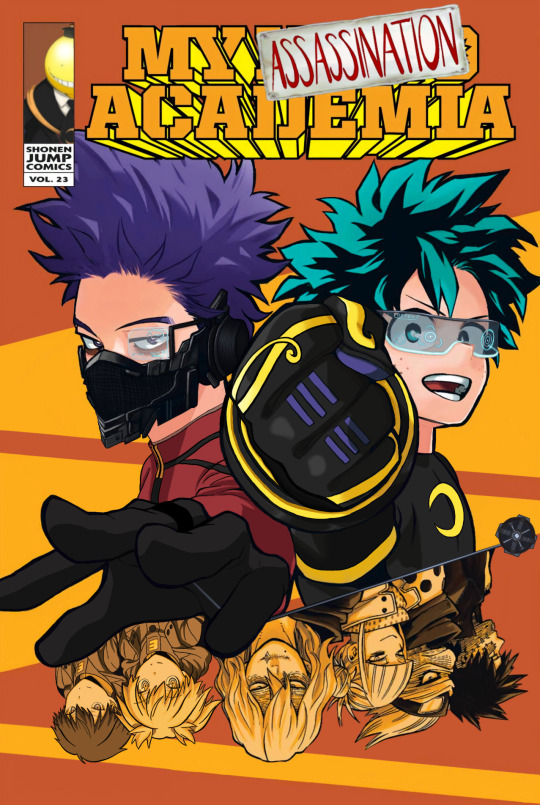
My Cover for Assassination Academia: A Very Extra BNHA x Assassination Classroom Series
Art and fic by me! (taetaenoway)
Art is rework the Shonen Jump Vol 23 cover. First time ever attempting non-traditional art. I think it went pretty well!
To Become a Hero - Chapter 12: To Make a Gambit IS NOW RELEASED! FINALLY!! I THOUGHT IT WOULD NEVER HAPPEN *LE SOBS*
Preview: Before this whole Civil War exercise even started, Hitoshi looked Karasuma in the eye and said, “This is going to go to shit.”
#im so sorry i abandoned yall for two years#i adopted a fur baby and got queerplatonically married wbu#i swear i didn't forget about this fic#first digital art pls be kind#not first fic feel free to hate#i return after so long only to cause more pain and suffering with an even bigger cliffhanger#this brings me no joy#thats a lie#all the joy#assassination classroom#bnha#bnha crossover#bnha art#assassination classroom art#fanfiction#shinsou hitoshi#midoriya izuku
314 notes
·
View notes
Text
Swoleton's fur is very soft and cuddly btw
#addistripes au#addistripes!spamton#surprisingly he grooms his coat regularly and showers several times a week#he just stinks because he works out all the time and lives in literal garbage#fur-preening is kind of a hard-wired instinct with addisons (like with cats)#spamton#brick speaks#worldbuilding#he neglects dental care and rarely cares about his claws but THE FUR MUST BE CLEAN#brick's aus#deltarune#spamton g spamton#swoleton
8 notes
·
View notes
Text

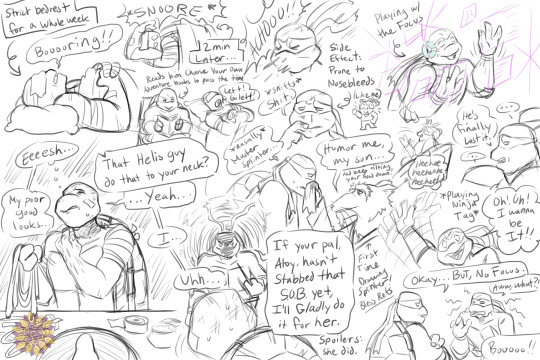

< Prev Doodles | Next Set of Doodles >
More for Pretend that I Never Left, except this time it's all post-fic hurt/comfort and fluff scenes I couldn't stop conjuring in my head at 5AM!! uwu @redstringraven I will laugh gleefully hard if I've somehow managed to predict Anything of what you're doing for the Epilogue
#tmnt#tmnt mikey#tmnt 2003#tmnt 2k3#aloy horizon#my art#fic fanart#my art show up in the search tags challenge#to be fair to myself#these scenes were not conjured during one lone 5AM#it was over the course of several 5AMs and also during work#the comic was so fun to make lol#can you spot all the visual funnies I put in there#also those outfits Mikey and Aloy are wearing are what my outfits would be if I lived in a cold environment#I mean sure it's like Chilly right now but not enough for Layers#also I'm very proud of my first Splinter doodles#old rat dad is filled with fur and angles but I think I did great#anyways!!#I will now wait (probably) for the Epilogue before doing more fanart of this AU that I love very much#edit with additional commentary about the playthrough I watched of HZD#which had Aloy choosing all of the heart/kind options until it came to the final battle with Helis#which was just like IMMEDIATE KILL KILL KILL#loved that lmaoo
125 notes
·
View notes